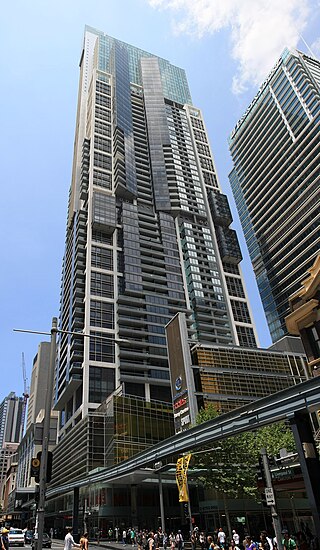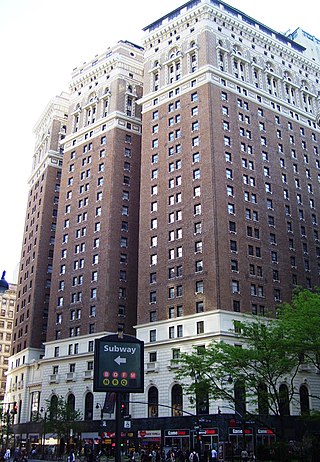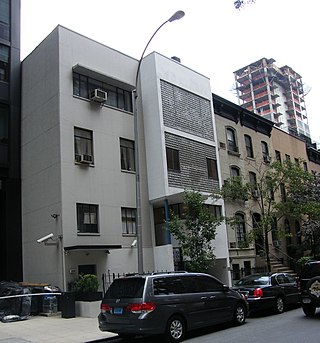
Jenners was a well-established department store in Edinburgh, Scotland, situated on Princes Street. It was Scotland's oldest independent department store until the retail business was acquired by House of Fraser in 2005. It closed in December 2020 and was vacated by House of Fraser in May 2021. The building will eventually be restored.

Woolworths was a British high-street retail chain. At its height, it operated as Woolworths Group PLC, which included other companies such as the entertainment distributor Entertainment UK, and book and resource distributor Bertram Books

Woolton Hall is a former country house located in Woolton, a suburb of Liverpool, England. Built in 1704 and extensively renovated in 1772 by the influential architect Robert Adam, the building is praised as the finest example of Adam's work in the North of England. Throughout its first 200 years, the building was the residence of a number of notable figures, including the Earl of Sefton and Liverpool shipowner Frederick Richards Leyland.

The Meier & Frank Building is a fifteen-story, glazed terra cotta building located in downtown Portland, Oregon, across from the northeast corner of Pioneer Courthouse Square. The building is the former flagship store and headquarters building for the Meier & Frank department store chain, which was taken over by Macy's in 2006. In 2006–2007, the building's lower five floors were remodeled as a Macy's, while the upper eleven floors were renovated in 2008 into a luxury hotel known as The Nines. Macy's closed in April 2017 and the lower levels were rebuilt as office space.

The Reliance Building is a skyscraper located at 1 W. Washington Street in the Loop community area of Chicago, Illinois. The first floor and basement were designed by John Root of the Burnham and Root architectural firm in 1890, with the rest of the building completed by Charles B. Atwood in 1895. It is the first skyscraper to have large plate glass windows make up the majority of its surface area, foreshadowing a design feature that would become dominant in the 20th century.
Owen Owen was a Liverpool-based operator of department stores in the United Kingdom and Canada. Beginning with a drapery shop in Liverpool, a chain of department stores was built up, often by taking over rival retailers. The company remained under Owen / Norman family control until the 1980s, and the brand ceased to be used in 2007.

The Clarendon Centre is a shopping centre in central Oxford, England, opened in 1984. The centre faces Cornmarket Street, and has other entrances onto Queen Street and Shoe Lane. The fascia onto Cornmarket Street is that of the Woolworths store which had, in a decision later criticised, replaced the Georgian Clarendon Hotel; it was discovered during demolition that medieval construction had been present within the hotel. The shopping centre was expanded in 2012–14. Major tenants include TK Maxx, H&M and Gap Outlet.

The Grand Hotel is a large hotel in Scarborough, North Yorkshire, England, overlooking the town's South Bay. It is a Grade II* listed building and owned by Britannia Hotels. At the time of its grand opening in 1867, it was the largest hotel and the largest brick structure in Europe.

World Square is a large shopping centre and urban development in the Sydney Central Business District.[1]

Herald Towers, formerly the Hotel McAlpin, is a residential condominium building on Herald Square, along Broadway between 33rd and 34th Streets, in the Midtown Manhattan neighborhood of New York City. Constructed from 1910 to 1912 by the Greeley Square Hotel Company, it operated as a short-term hotel until 1976. The building was designed by Frank Mills Andrews in the Italian Renaissance style and was the largest hotel in the world at the time of its completion, with 1,500 guestrooms. The hotel was expanded in 1917, when Warren and Wetmore designed an annex with 200 rooms.

SouthGate is a shopping centre in Bath, Somerset, England, It is home to over fifty shops, ten restaurants, 99 homes and an 860-space underground car park. It replaced a shopping centre which was demolished in 2007.

Kirkcaldie & Stains was a department store in Wellington, New Zealand. It was established in 1863 by John Kirkcaldie and Robert Stains with a capital of £700. The first store was opened on Lambton Quay. In 1868 Kirkcaldie & Stains moved to their final location at the corner of Lambton Quay and Brandon Street, expanding several times. There was a branch on Cuba Street, Wellington from 1870 –1876 and one in Napier from 1897 until 1917. French luxury skincare brand Sisley was exclusive to the store in New Zealand.

The Flood Building is a 12-story highrise located at 870 Market Street on the corner of Powell Street in the downtown shopping district of San Francisco, California completed in 1904 and designed by Albert Pissis. Situated on Powell and Market streets, next to the Powell Street cable car turntable, Hallidie Plaza and the Powell Street BART Station entrance, it is one of the few structures that survived the 1906 San Francisco earthquake.

Haigh Hall is a historic country house in Haigh, Wigan, Greater Manchester, England. Built between 1827 and 1840 for James Lindsay, 7th Earl of Balcarres, it replaced an ancient manor house and was a Lindsay family home until 1947, when it was sold to Wigan Corporation. The hall is recorded in the National Heritage List for England as a designated Grade II* listed building and is owned by Wigan Council.

J Ballantyne and Company Ltd, trading as Ballantynes is a Christchurch, New Zealand-based department store operator. Established in 1854, it is New Zealand's oldest department store. Ballantynes is also a member of the Intercontinental Group of Department Stores. Alongside their flagship store in Christchurch Central City, the Cantabrian company operates a store in Timaru. The company also operates Contemporary Lounge, offering more youth-oriented fashion styles within the Christchurch store.
Hanningtons was a department store located in the English coastal city of Brighton and Hove. Prominently situated in a central position in Brighton, it had an unbroken history of trading for nearly 200 years until its closure in 2001. It was the city's oldest, largest and most diverse department store: its 70 departments offered clothes and household goods of all types, and services ranging from funeral arrangement to carpet-cleaning. "Famous" and "prestigious", it was known locally as the "Harrods of Brighton". It remained in family ownership until the 1960s, and subsequent owners ran the business according to the principles of the Hannington family.
Thomas Charles Sorby was an English-Canadian architect. Born in Wakefield, England, he emigrated to Canada in 1883, where he worked for much of the time in Vancouver and Victoria, British Columbia.

The Ritz Tower is a luxury residential building at 465 Park Avenue on the corner of East 57th Street in the Midtown Manhattan neighborhood of New York City. It was built from 1925 to 1926 as an apartment hotel and was designed by Emery Roth and Thomas Hastings for journalist Arthur Brisbane, who was the developer. The Ritz Tower is about 541 feet (165 m) with 41 stories, making it the tallest residential building in New York City upon its completion. Because it was initially classified as an apartment hotel, the building was constructed to a greater height than was usually permitted.

The Lescaze House is a four-story house at 211 East 48th Street in the East Midtown and Turtle Bay neighborhoods of Manhattan in New York City. It is along the northern sidewalk of 48th Street between Second Avenue and Third Avenue. The Lescaze House at 211 East 48th Street was designed by William Lescaze in the International Style between 1933 and 1934 as a renovation of a 19th-century brownstone townhouse. It is one of three houses in Manhattan designed by Lescaze.

Milne & Choyce was one of the first department stores in Auckland, New Zealand. The upmarket department store grew from a draper's and milliner's first acquired by Mary Jane and Charlotte Milne in 1867. In 1874 the store moved to larger premises on Queen Street, before the name of the store changed to Milne & Choyce in 1876 following Charlotte Milne's marriage to Henry Choyce.




















